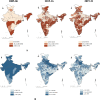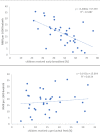First 72-hours after birth: Newborn feeding practices and neonatal mortality in India
- PMID: 37796893
- PMCID: PMC10553319
- DOI: 10.1371/journal.pone.0292353
First 72-hours after birth: Newborn feeding practices and neonatal mortality in India
Abstract
Background: The reductions in mortality levels among children under five years are observed in most populations, including populations that were lagging the progress in the past. However, the reduction is not uniform across ages during childhood. The mortality declines within the first month have shown relatively slow progress. Early initiation of breastfeeding and discarding pre-lacteal feed protects the newborn from acquiring infection and, thereby, reduces mortality. This paper assesses the change in the prevalence of early initiation of breastfeeding and pre-lacteal feed along with their associated factors, and their association with neonatal mortality in India.
Methods: We used data from the three rounds of National Family Health Surveys conducted during 2005-06, 2015-16 and 2019-21 in India. We used bivariate and multivariate analyses to examine prevalence rates, risk factors, and relationships between breastfeeding practices, including early initiation of breastfeeding and pre-lacteal feed, and neonatal mortality.
Results: Early initiation of breastfeeding within one hour after birth increased rapidly from 25% in 2005-06 to 42% in 2019-21, and the pre-lacteal feeding practice declined from 57% in 2005-06 to 15% in 2019-21. Pre-lacteal feed is lower in states/districts where early breastfeeding initiation is predominant and vice versa. The role of health professionals during pregnancy and the first two days after delivery significantly improved breastfeeding practice. Further, the findings suggest that an early breastfeeding initiation is associated with lower neonatal mortality, whereas pre-lacteal feed is not harmful compared to late breastfeeding initiation.
Conclusion: Prevalence of pre-lacteal feed reduced, and initiation of early breastfeeding increased considerably after the launch of the National Rural Health Mission in India. However, after 2015-16, early breastfeeding initiation has stagnated, and the decline in pre-lacteal feed has slowed down. The future program needs special attention to emphasize the availability and accessibility of breastfeeding advisers and observers in health facilities to help mitigate adverse neonatal outcomes.
Copyright: © 2023 Mal, Ram. This is an open access article distributed under the terms of the Creative Commons Attribution License, which permits unrestricted use, distribution, and reproduction in any medium, provided the original author and source are credited.
Conflict of interest statement
The authors have declared that no competing interests exist.
Figures



References
-
- Perin J, Mulick A, Yeung D, Villavicencio F, Lopez G, Strong KL, et al. Global, regional, and national causes of under-5 mortality in 2000–19: an updated systematic analysis with implications for the Sustainable Development Goals. Lancet Child Adolesc Heal. 2022;6: 106–115. doi: 10.1016/S2352-4642(21)00311-4 - DOI - PMC - PubMed
-
- United Nations Inter-agency Group for Child Mortality Estimation (UNIGME). ‘Levels & Trends in Child Mortality: Report 2021, Estimates developed by the United Nations Inter-agency Group for Child Mortality Estimation. New York; 2021.
-
- World Health Organization. Newborn Mortality. 2022. Available: https://www.who.int/news-room/fact-sheets/detail/levels-and-trends-in-ch...
-
- Office of the Registrar General & Census Commissioner. SAMPLE REGISTRATION SYSTEM (SRS)-STATISTICAL REPORT 2020. India (ORGI); 2022.
MeSH terms
LinkOut - more resources
Full Text Sources
Medical
Miscellaneous

